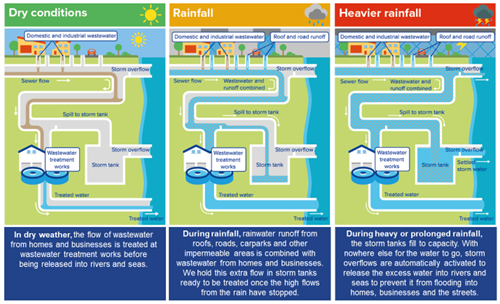Everything you need to know about storm overflows, why they’re used and what we’re doing to reduce releases from them.
Did you know our sewer system was built by Victorians in the 1850s? Back when the population was much smaller, there were fewer roads and more green spaces.
Fast forward 170 years, what was once a green field able to soak up and use rainwater is now a main road. As unpredictable weather increases and places for the rainwater to go decrease, the sewer network is under more pressure. As a result, storm overflow releases have become more common.
If we were to replace the sewer network, as a way of combating the use of overflows, not only would it take years to complete, but it would be incredibly expensive and cause a lot of disruption along the way. But the environment can’t wait that long. We understand our customers want action now, which is why we’re investing in sustainable long-term solutions.
Let’s take a deep dive into everything you need to know about storm overflows and more importantly, what we’re doing about them.
What is a storm overflow?
During heavy rain, local sewer networks can struggle to cope with the amount of water entering pipes and storage tanks. When they fill up, we use pressure relief valves built into the network – known as storm overflows – to stop homes and businesses from flooding. These overflows release excess water through outfalls into rivers and the sea.


Quick-fire facts
- Storm overflow releases are regulated by the Environment Agency, they control our permits.
- They’re often highly diluted with rainwater and groundwater.
- They’re mainly caused by water runoff from impermeable area like carparks, roads and roofs.
- We have almost 1,000 storm overflows in our region and 50% of these are already hitting the government’s 2050 target, releasing 10 times or less a year.
What we’re doing…
Although we can’t control the weather, we can invest in projects to reduce the use of storm overflows. In fact, between now and 2025, over £35 million will be invested to do just this, and we haven’t paid any external dividends since 2017 to make sure we’re investing as much as we can into improving our performance.
Here’s just a handful of ways we’re reducing their use, slowing the flow, and preventing flooding.
Clean Rivers and Seas Task Force
In November 2021, we set up our Clean Rivers and Seas Task Force. The task force is responsible for delivering Pathfinder projects through an accelerated programme to reduce the use of storm overflows over the next two years, collaborating across industries as well as with local authorities and the public.
We’ve built our Clean Rivers and Seas (regional) plan. This is hosted on a public interactive map to show how the company will reduce storm overflow releases between 2025-2050, in line with regulatory and government targets.
Head of The Clean Rivers and Seas Task Force, Nick Mills, said: “We’ve come a long way since the Task Force was set up and we’ve learnt a great deal which has shaped our delivery approach and the Clean Rivers and Seas Plan to tackle storm overflows. We’re now scaling our initiatives and delivering in all Pathfinder areas, and we’re seeing real results.”
Pathfinder projects
We have six Pathfinder projects dotted around the region. With involvement from local councils and the communities around them, these projects involve us trailling sustainable, long-term solution to reduce storm overflows.
From infrastructure improvements to sustainable drainage systems (SuDS) like slow-drain water butts and constructed wetlands, our Pathfinder projects are taking the pressure off our sewer network and reducing how often storm overflows are used. The Isle of Wight is home to one of these projects, where we gave slow-drain water butts to residents in Havenstreet, and as a result saw a 70% reduction in the use of the local storm overflow. The results show just how crucial these projects are, and that green solutions offer a sustainable way forward.
Find out more on the projects here: Pathfinder Projects
